The Google Nexus 5X Review
by Brandon Chester on November 9, 2015 8:00 AM EST- Posted in
- Smartphones
- LG
- Mobile
- Android 6.0
- Nexus 5X
Display
A smartphone's display is unquestionably one of its most important aspects, and failing to deliver a good display can be a fatal flaw for a device. If the screen doesn't have sufficiently high brightness and contrast then its usability with high ambient lighting will be severely crippled. Inaccurate color rendition will cause photos and videos that are taken and viewed on the device to look radically different from other devices. Pushing a wide color gamut can also have ramifications that go beyond making the display inaccurate, such as reducing battery life on AMOLED devices by having to drive a higher voltage in order to achieve the wider gamut.
Last year's Nexus 6 ended up being a significant disappointment as far as the display was concerned. It was immediately obvious to me that the gamut was far too large, and that peak brightness was too low. My testing confirmed both of these things, and I was disappointed mainly because the Nexus 5 from the previous year sold for significantly less than the Nexus 6, and sported imperfect but relatively good display calibration. While this year's Nexus 6P is an AMOLED display that we are yet to test, the Nexus 5X sports an IPS LCD like its predecessor. At 5.2", this year the display is a bit bigger than the 4.95" Nexus 5, but it's still a far cry from the 5.96" display that was on the Nexus 6.
To analyze the quality of the Nexus 5's display I've run it through our standard display testing suite. As always, displays are calibrated to 200nits of brightness, and results are measured with an i1Pro 2 spectrophotometer, and managed using SpectraCal's CalMAN 5 software. Contrast measurements are done with an i1Display Pro colorimeter due to the i1Pro 2's more limited accuracy with very low brightness levels.
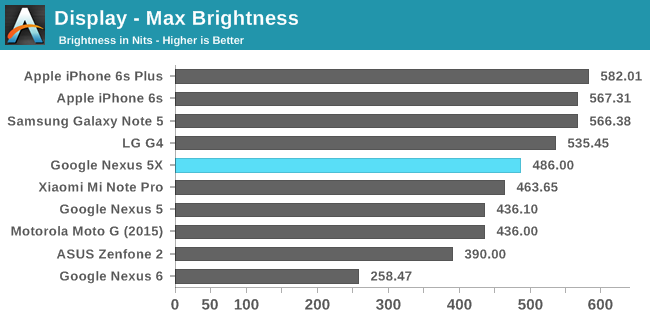

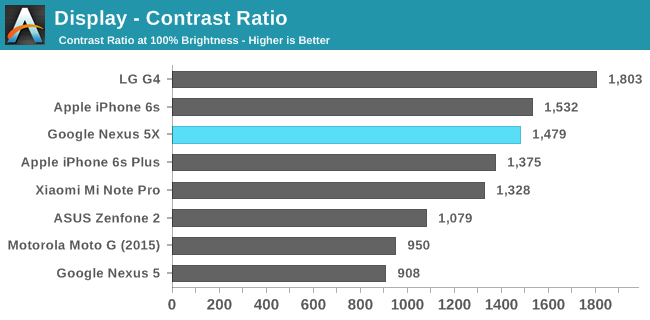
The most basic data point to examine when moving beyond resolution is a display's maximum brightness and its contrast ratio. The Nexus 5X does very well here, with a peak brightness of 486 nits, and a minimum black level of 0.32 nits, which leads to a contrast ratio of 1479:1. This is the result of the use of photo-alignment to influence subpixel orientations and reduce light leakage, which results in deeper blacks and thus a higher contrast ratio. While many other LCD-based smartphones are also using this technology, to see it applied to a $379 smartphone is very exciting. The display's maximum brightness is also a healthy improvement over the Nexus 5, and I haven't run into any situations where the display can't get bright enough to counter glare from the cover glass.
Something that doesn't really show up in any of our figures is the visibility of the display's capacitive sensors. On the Nexus 5 these were fairly noticeable when there was any light shining on the display, and this is unchanged on the Nexus 5X. This is something that can be observed on every device with capacitive touch, although on AMOLED devices and iPhones it's extremely hard to see. I only felt it was worth pointing out because it does seem more pronounced on the Nexus 5X than some of the other devices I have.
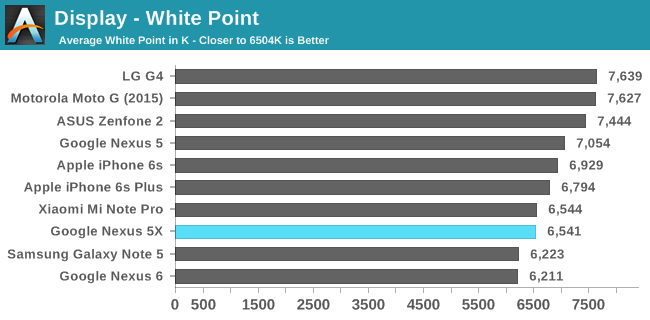
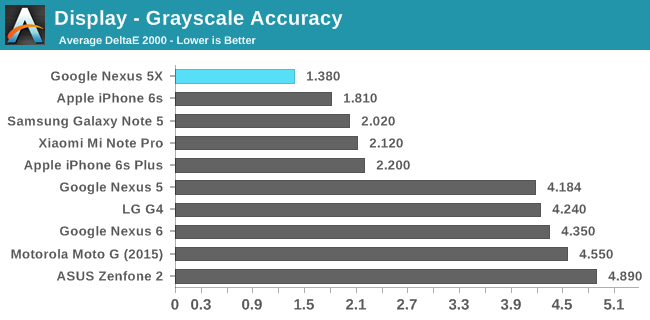
Greyscale accuracy on the Nexus 5 is impeccable. Gamma does tend slightly upward as one moves past the 20% mark, but it's still quite accurate and most greyscale errors are approaching the point where the human eye could not even distinguish them from their reference colors when placed side by side. The RGB component balance for each shade of grey is also very good, and the display's average white point is only ever so slightly above the targeted 6504K. There's not much more to say, as this level of calibration is exceptional for a device of this price. The Nexus 5 certainly had fairly good calibration, but issues with the gamma made the display appear washed out which was a common complaint, and the Nexus 5X resolves that while also boosting accuracy significantly.
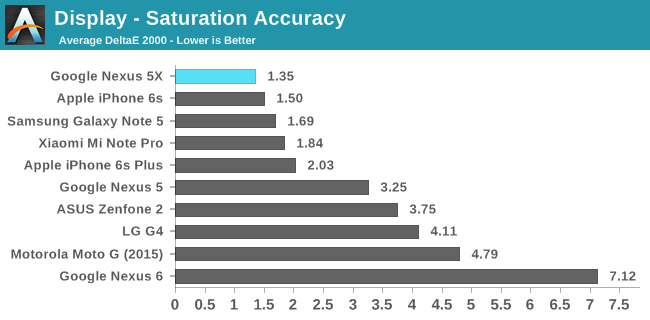
The accuracy for 20% saturation steps on the Nexus 5X is also incredibly high. It's actually the lowest DeltaE on record for a smartphone - lower than even the Galaxy Note5 and iPhone 6s - and there's honestly nothing at all that I could criticize about the rendition of primary and secondary colors on the display. The chart above also shows how much improvement has been made compared to the Nexus 5 and Nexus 6, with the latter being especially bad due to its overly wide gamut.
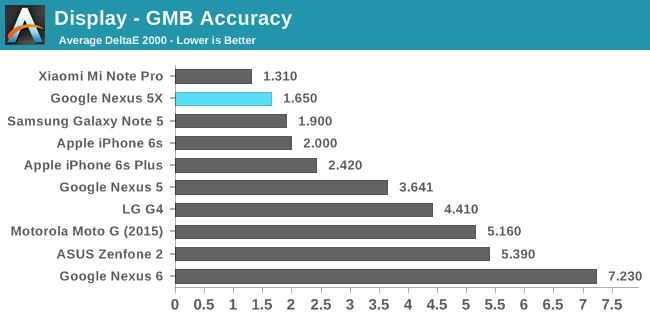
Once again the Nexus 5X provides an incredibly high level of accuracy, with color mixtures being reproduced almost as accurately as primary and secondary colors. It's not the absolute best result on record due to the Mi Note Pro's even higher level of accuracy, but you would only be able to tell that the rendition is wrong if you had the color right beside the reference color with absolutely no motion occurring, and that's well beyond the level of accuracy that is really necessary for a mobile device.
I really don't know what else to say about the Nexus 5X's display, because there's really nothing that can be criticized. I would certainly like if the brightness went up to 600 nits, but I would also prefer that it went to 6000 nits, and obviously that's asking a bit much. As far as LCDs go, the Nexus 5X has one of the best, if not the best that I've seen to date. At this point Google and their OEM partners are going to have to look to gamut as a vector of improvement, but only after proper color management is available at the OS level in order to avoid the problems that have plagued wider gamut displays, which have lacked suitable color management to properly map sRGB content into the wider color space.


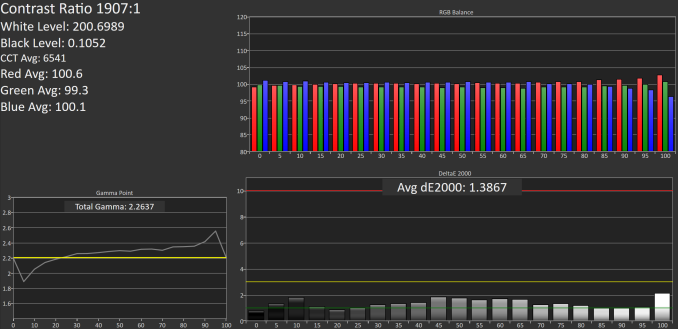
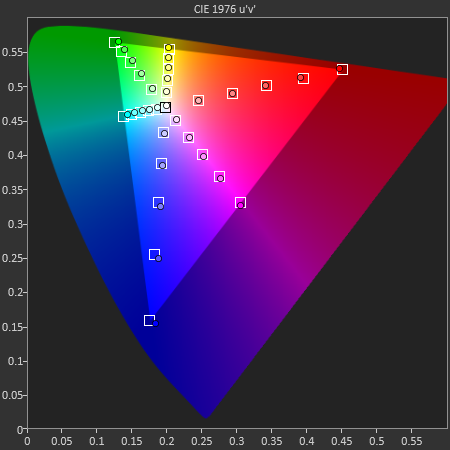









197 Comments
View All Comments
syxbit - Monday, November 9, 2015 - link
I'm really glad this review took a serious look at many low level design decisions.Many other reviews simply praised the 5X. The screen, fingerprint reader and camera are fantastic. Battery life seems good, as is the form factor and price. However, Qualcomm completely screwed the pooch in 2015. I'm glad that's duly noted.
No hardware encryption is a real shame, as is the lack of UFS 2.0, USB 3.0 and OIS. At this pricepoint, it's possibly acceptable. But if Google is really supposed to be raising the bar, and teach other OEMs how to build a phone, they've missing a few things.
And that's why the Nexus 5 was Google's best ever nexus. Qualcomm was on top of the world with the SD800, and lack of encryption meant the storage performance and battery problems associated with it didn't exist. Two years have not brought the advancement they should have.
Many of these problems are acceptable at this price point, but I'm less forgiving at the N6P price point. The sad state of Android right now is that despite the hundreds of hardware options, if you want pure Android, you have about as many options as an iPhone buyer.....
I bought the N6P because there are no other compelling Android devices. Don't get me wrong, I'm very happy with it. But I'd much rather have an Android phone with Apple's SoC and hardware encryption, Samsung's UFS storage and Sony's battery life.
zeeBomb - Monday, November 9, 2015 - link
UFS 2.0 is totally new NAND though. While its still a relatively new addition to flash storage devices, I can see more devices other than Samsung using it in the future.sci2 - Monday, November 9, 2015 - link
I agree with your last points - It's why I imported a Sony Z5 (to the US). Nearly stock Android, waterproof, expandable storage, excellent battery life and camera. Basically, what in my mind, the 5x should have been. Three weeks in and I'm loving it. My (absolutely terrible) S6 is waiting for a new home on craigslist.konondrum - Monday, November 9, 2015 - link
Why do you not like your s6? It's certainly the best phone I've ever owned. My biggest complaint is the fingerprint scanner isn't as reliable as it should be. I'm somewhat hopeful that an update to the Marshmallow API will help, but I'm not counting on it. Otherwise, once I installed the Google Now launcher (TouchWiz is still gaudier than even iOS) it's been very smooth sailing for me.MykeM - Wednesday, November 11, 2015 - link
What would you want the slower UFS 2.0 instead of the iPhone 6s' NVMe/PCIe storage solution.melgross - Monday, November 9, 2015 - link
One thing I disagree with in the camera testing is that if HDR+ is going to be shown for a model, then it's required that HDR be tested for every other phone that's being compared to it. And where is the Galaxy S6 in most of these tests? That much closer to this than the Note 5.Brandon Chester - Monday, November 9, 2015 - link
The SoC in the Note 5 behaves the same as the S6, and I specifically added the S6 into the battery charts.blahsaysblah - Monday, November 9, 2015 - link
I noticed that they moved the power and charging port both to the bottom.Did you have any issues with that configuration?
Android on Nexus didn't support landscape mode for longest time in non-tablet mode(i think it was re-introduced to Nexus phones in 5.0). It still doesn't support upside down mode. I can understand a little because microphone/speaker placement. It would still be better if it forced/switched to right side up when calls came in and let you use apps with phone upside down until necessary.
Any issues with all cables on bottom?
Brandon Chester - Monday, November 9, 2015 - link
I'm pretty used to having all the cables on the bottom of a phone at this point so it never posed an issue.LoneWolf15 - Monday, November 9, 2015 - link
Every review I've read so far convinced me to buy a Nexus. Only it was a slightly used Nexus 6.The Nexus 5X and 6P lack wireless charging (and I already have a Qi charger). They lack Quick Charge/Turbo Charging, which the 6 has. The 5X lacks 3GB of RAM, and the big battery I was hoping they would have (I honestly wanted a phone the size of the 5X, but I can't have everything). And I could save over $100 buying a slightly used 32GB 6 over a 32GB (I don't even know why they released a 16GB) Nexus 5X. The only thing I don't get is a fingerprint reader.
I wanted a phone the size of a 5X, but with more features, and that wasn't an option. And the 6P wasn't really what I wanted either. The closest to what I wanted would be the Moto X Pure, which doesn't offer me the updating schema of the Nexus brand. I continue to wait for the ultimate Nexus in a 5.2-5.5" display I can use one-handed, but I'm not holding my breath.